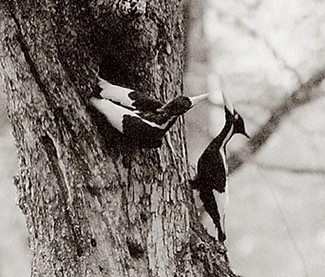Creature
Fast Facts
Introducing you to extinct species.

THE
IVORY-BILLED WOODPECKER
1. The ivory-billed woodpecker, Campephilus principalis, was/is the largest species of woodpecker in the United States. Only the extinct Imperial woodpecker from Mexico was larger. 2. It was nicknamed the "Lord God" bird because when people saw it they would yell, "Lord God, what a bird". 3. It went extinct in 1944, but was "rediscovered" in 2004, but declared extinct in 2021 after a lack of proof was found to prove its existence. 4. It was known for its tinny "kent, kent" call and its double knock. 5. Older common names included Log Cock, Log God, Good Lord, Indian Hen, Kent, Kate, Poule de Bois (French for Wood Hen), and Tit-ka in Seminole. 6. The ivory-billed woodpecker was 21 inches long with a 30 inch wingspan with a ivory colored beak from which it gets its name. 7. It is often mistaken for the common pileated woodpecker, but the ivory bill has a unique white pattern on its wings. 8. It is considered the "Holy Grail" for bird watchers. 9. There are many cash rewards for definitive proof of its existence, the largest being $50,000. 10. They had a diet of beetle larvae, acorns, hickory nuts, and wild grapes. 11. The male and female are similar in size and shape, but the male has a distinctive red crest. 12. The ivory-billed woodpeckers originally ranged in the old growth swamps from Texas though Florida. They were reported by Thomas Jefferson in Virginia and as far north as Maryland. 13. Many Native American groups traded the ivory bill for ceremonies and decoration. Some ivory bills were found in graves over 300 miles beyond the ivory-billed woodpecker's range. 13. The Singer Sewing Company owned an old growth section of forest where the last confirmed sightings of the ivory-bills were in Louisiana in 1944. 14. Brinkley, Arkansas celebrates the ivory-billed woodpecker at the Big Woods Birding Festival along the Cache River. 15. The ivory-billed woodpecker was declared "endangered" on March 11, 1967, 23 years after its last confirmed sighting.
Extinction
Cometh
Facing the light at the end of the tunnel
EXTINCTION DATE
April 1944?
The ivory-billed woodpecker once ranged from Texas to Florida in the southern United States, and as far north as Maryland. They originally could be found in many old growth pine forests. Many Native American tribes traded the ivory colored bills as decorations, with some being found as far north as Iowa & Colorado. As America expanded westward, many old growth forests were cleared for farms and for timber. This destruction of forests moved the remaining ivory-billed woodpeckers into the old growth forests of the southern swamps. Besides the loss of habitat, the ivory-billed woodpeckers' feathers were used as a late 1800's fashion statement. Some pioneers ate the ivory-bill as well. By the late 1800's, the ivory-bill population was on a steep decline. During WWI & WWII more forests were cleared to support the war effort. Many scientists believed the ivory-billed woodpecker was extinct by 1920, until there was a confirmed sighting in 1924 in Florida. The next confirmed specimen was killed by Louisiana state representative, Mason Spencer in 1932. A team of scientists studied 20-24 ivory-billed woodpeckers in the Singer Tract of land in Louisiana. The National Audubon Society tried to buy the land from the logging company, but their offer was rejected and the forest was cleared. The last confirmed sighting was in April of 1944 as the clearing of the Singer Tract of forest was almost near completion. The United States Fish & Wildlife Service declared the ivory-billed woodpecker "endangered" on March 11, 1967 over 20 years after its last sighting. In 2004, Gene Sparling reported seeing an ivory-billed woodpecker in the Cache River National Wildlife Refuge in Arkansas. This was huge news as the "Holy Grail Bird" had apparently been rediscovered. The excitement grew when top ornithologists, Tim Gallagher and Bobby Harrison, went to investigate and reported they saw an ivory-billed woodpecker as well, although they lacked clear photographic evidence. Since then many people and organized teams have searched the swamps of Arkansas, with many reported encounters but no clear proof. In September of 2021 the U.S Fish and Wildlife Service officially declared the ivory-billed woodpecker (and 22 other species) extinct. See the full article under the "Extinct Species" tab. Could the ivory-billed woodpecker live in the American Northeast today? Although Jurassic Park is fiction, scientists are working on several de-extinction projects. In fact, in 2003 scientists did bring back the extinct Pyrenean ibex, a type of wild goat, for 7 minutes before it died, showing de-extinction is possible. The ivory-billed woodpecker would be a great candidate for this. Scientists would potentially use DNA from the hundreds of museum specimens to use to try to bring them back to life. Great strides have been made to preserve wildlife and restore habitats since the ivory-billed woodpecker’s extinction in 1944. The Cache River National Wildlife Refuge has been protected for a long time and the habitat continues to bounce back. The locals of Brinkley, Arkansas celebrate the potential sightings of the ivory-billed woodpecker. The laws to protect the woodpecker and its habitat will need to be balanced with the hunting laws of the area, so the locals can fully support protection efforts. If the ivory-billed woodpecker was brought to life, could it ever be reintroduced to its native homeland swamps in the American Southeast?
NEW STORY
Would they welcome me back with open arms? Would they still shout “Lord God!” as I flew over their heads? Could I handle the fame, the parades, the glory, and still stay humble? Only time would tell. Who am I? I am the ivory-billed woodpecker, also known as the Lord God bird, because of my impressive size. I used to live in the old growth swamps of the southern United States, but I couldn’t avoid the hunters or bring myself to stay in smaller trees. What can I say? I was a picky nester. Our last true home was owned by the Singer Sewing Company. It was an old growth section of forest in Louisiana which is where we made our last stand as a species.
More to Explore
All answers lead to more questions

A book about extinct Species including the ivory-billed woodpecker
Image from Amazon
VIDEOS & ADDITIONAL INFO
Revive & Restore - De-Extinction Website
North American Extinct Birds - Atlas Pro Video
Recordings of Ivory Billed Woodpecker (1935)
"Knock on Wood" - Little Einsteins Show
Extinct or Alive - Ivory Billed Woodpecker Episode
23 Species Now Extinct - PBS New Article
60 Minutes - The Lord God Bird Video
Video Containing Facts & Historic Footage

Photo taken from Singer Tract in Louisiana in 1935
Image from Wikipedia

Juvenile ivory-billed woodpecker
Image from
Lost Animals

Juvenile ivory-billed woodpecker
Image from
Lost Animals


There have been many cash rewards for evidence of an ivory billed woodpecker including this $50,000 reward.
Image from Pinterest
Map of ivory billed woodpecker sightings since 1944
Image from Bird Watching Magazine

Image from Ashley Hersee Illustration

Painting of an ivory-billed woodpecker
Image fromNature Artists

Photo from 1935 of a pair of ivory-bills
Image from Wikipedia

One of over a dozen books listed on Amazon
Image from Amazon

A book about the "rediscovery" of the ivory billed woodpecker in 2004
Image from Amazon

Ivory Bill Brewing Co. in Arkansas
Image from Ivorybill.com

Ivory-billed woodpecker pair on display
Image from Florida Museum of Natural History

A photo I took of a male ivory-bill
Display at Field Museum in Chicago

A photo of the Imperial woodpecker that went extinct in Mexico in 1956
Display at Field Museum in Chicago











Flight difference diagram of pileated woodpecker vs the ivory billed woodpecker
Image from Wikipedia




